Babies usually start crawling between 6 and 10 months, and this developmental milestone is essential to assess your child’s overall mental and physical development.
As a new parent, you might be worried if you start to see your baby crawling with one leg out. Does it mean that there’s something wrong with your little one?
It’s quite normal for some infants to combine several crawling techniques, or even skip crawling altogether.
Keep on reading to learn more about the different stages and styles of crawling.
Content:
- Proper Crawling Signs
- Different Types of Crawling
- Why Do Some Babies Crawl with One Leg Out?
- What are the Stages of Crawling?
- Is Crawling with One Leg Out Dangerous?
- Does Crawling Differently Mean that my Child is Autistic?
- How to Encourage Your Child to Crawl on All Fours
- What Should You Avoid When Your Baby is Crawling?
- My Baby isn’t Crawling- When Should I Worry?
- When Do Babies Start Walking?
- What Signs Show that my Baby will Walk Soon?
- How Can I Encourage my Baby to Walk?
- When Will My Baby Walk Independently?
- What Should I Do if My Baby is a Late Walker?
Signs of Proper Crawling
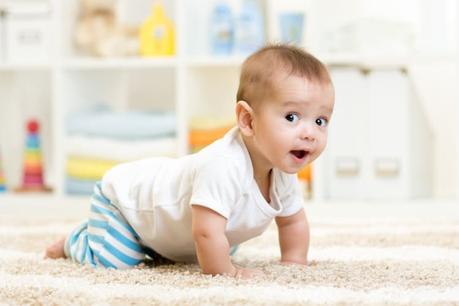
Although some babies don’t crawl at all, those who do are likely to enjoy better spatial and mental development.
For babies, crawling isn’t just about going from spot to another, but it’s a crucial milestone in their overall development.
Nevertheless, it’s essential to know that there’s no one right way of crawling, so you shouldn’t worry if you think that your little one is crawling differently.
Before crawling, your little one will learn a few things to stabilize and support the body before learning the crawling movement.
First, your infant will support the upper body part using the arms and hands and will learn to lift their head off the ground and maintain this position for a while.
After that, your child will learn to stabilize themselves on all fours before learning to swing back and forth without moving.
This practice will help your child stabilize their body and strengthen their muscles.
In most cases, your child will start crawling to reach something that they can’t get to with their outstretched hand.
They will try to stretch their arm and hand to reach a toy that they want to grab and probably fall when they lose balance.
However, this step will teach them that they can move a little bit forward this way.
Crawling is related to problem-solving skills because your child will try to reach something without any help.
It allows children to explore their surrounding environment and get in touch with the people and objects they want to reach.
In the beginning, crawling might not be easy, but as your child practices, the movement will become more automatic.
Here are some of the benefits of crawling.
#1 Crawling helps strengthen the muscles in the neck, head, arms, back, and leg.
It’s a crucial step in developing gross motor skills as the arms and legs move to support the body later on when the baby learns to walk.
At the same time, it promotes fine motor skills as the hands and fingers support the body.
#2 When babies crawl, their bodies touch various surfaces, and they explore different textures as they go from the cold tile to the warm rug.
#3 Babies learn to look at the object they want to reach as well as their hands when they’re crawling.
As a result, it helps improve the vision as children understand the objects in their environment and the distance between them and their destination.
#4 Practicing crawling will promote balance and coordination between the 2 sides of the brain. It also promotes coordination between vision and movement.
#5 Children will also enjoy a sense of achievement that promotes self-confidence. With the parents’ encouragement, your baby will be tempted to crawl even more after learning from failure and how to overcome it.
Nevertheless, this doesn’t mean that all kids have to follow the same steps when they’re crawling. As a matter of fact, there’s no right or proper way of crawling.
However, classical crawling is the most common type. Here are some signs that your baby is crawling properly.
- Your little one will be positioned and balanced on all fours in a typical crawling position before trying to move forward.
- The knees should be at the width of the hips to help balance the body better.
- Your child should try to use both sides of the body, alternating the right and left limbs to move forward.
- The child will move one knee at a time and might spend some time balancing on one knee before moving again.
- Typical crawling involves symmetrical movements between the 2 halves of the body. When the right arm moves forward, the left leg will move forward and vice versa.
- While crawling, the baby’s core should be engaged, so the back won’t be too arched.
Some babies will start asymmetrical crawling or even scoot and drag their bodies across the floor to move forward.
If your baby is crawling differently, this doesn’t mean that there’s something wrong with them.
Different Types of Crawling
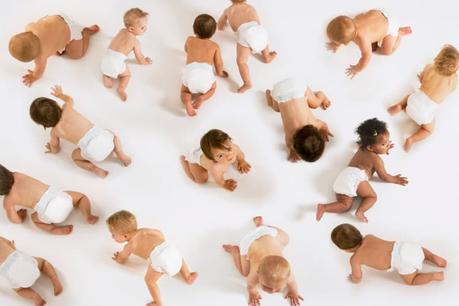
Babies use crawling to pull their bodies forward. Every baby will use different body parts to achieve balance and move forward, so you shouldn’t feel alarmed if you don’t think that your baby is crawling the right way.
Here are the most popular types of crawling.
Classic Crawling
This is the most common type of crawling where the baby will balance on all fours. Your infant will move one arm to the front while moving the opposite knee at the same time.
Belly Crawling
Babies can start belly-crawling before shifting to classic crawling. They usually drag their tummies across the floor while maintaining support with their arms.
This crawling method is easier than the classic one because the baby doesn’t need to balance on all fours.
Some children will stick to this method until they learn how to walk. It’s also known as Commando Crawling.
Bear Crawling
In this position, your baby will also balance on all fours, but he or she will crawl with their limbs unbent. The back will be arched, and the child will have to lift their head to see their surroundings.
Crab Crawling
You might see your infant struggling to move forward if they use this crawling method, which often helps them to move backward or to the side.
In this position, the baby will push rather than pull with the arms, which usually sends them to the back.
This can make the baby a little bit frustrated as they feel that they’re unable to go where they need to.
Nevertheless, some babies adjust to this technique and will position themselves differently until they can reach their desired destination, although they’re moving backward.
Bunny Hop Crawling
Babies learn to crawl using both their hands simultaneously or to hop while supporting both knees.
In the long run, this type of crawling can affect your baby’s overall mobility and their ability to achieve balance while standing up or walking.
Bum Crawling
Your infant will sit upright and support their weight on their bottom. They will propel their body to the front while using arms for support, and without engaging the legs.
In some cases, the legs might bend forward, or one of them might be flat.
Although some kids find this style to be very comfortable, the child won’t be able to strengthen the head and neck muscles in this position.
If one leg is extended, the spine and the hips might be tilted to one side, leading to the formation of scoliosis.
In the future, the child might face problems while standing or walking because they prefer to use one leg over the other.
Roll Crawling
Although this is not a type of crawling in a technical way, some babies still use this method to move their bodies from one location to another.
The child will roll from one side to another to move, and they might start crawling later on, or use this method until they learn to walk.
It’s quite common to see your baby shifting from one style to another, or combining several techniques until they’re most comfortable.
All of these styles are quite normal and shouldn’t alarm you. They can represent crawling stages that allow your baby to strengthen their muscles and achieve balance before they’re ready for walking without any help.
Why Do Some Babies Crawl with One Leg Out?
Some infants start crawling while extending one leg out and relying on the other to propel their body to the front.
This can happen because there’s muscle weakness on one side of the body.
It can also be caused by the asymmetry of muscles or lack of body awareness. In this case, the child might not be aware of their true midline, and this pattern will encourage the use of one side of the body over the other.
Crawling with one leg out or Asymmetrical crawling is rather common in babies and is characterized by the following.
- The baby will use one arm and one knee to move their body to the front or the side.
- The other leg and arm will remain idle.
- The pelvis and the spine will be shifted to one side.
You can notice that the baby prefers one hand over the other while grabbing toys or interacting with others.
What are the Stages of Crawling?
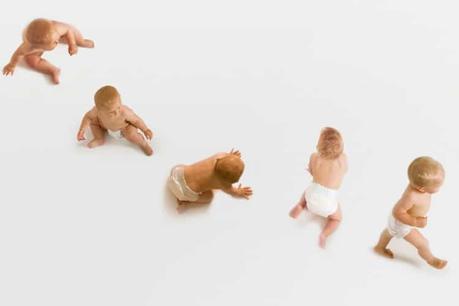
Tummy time allows infants to strengthen their muscles and prepares their bodies for crawling.
As babies develop more muscle control, they will start going through the following stages before crawling.
- Your baby will start to do the plank while balancing on their arms and feet or knees and hands.
- Most babies will lay on their tummy and start moving in circles or pivoting.
- While balancing on their hands and knees, your child will start rocking back and forth.
- Your infant will try to take one step while being supported by their tummy or hands.
- Your child might try to move forward, but end up moving backward.
Your baby might not go through all these stages before they actually start crawling. There’s no right or wrong because babies, just like adults, are all different and unique.
Is Crawling with One Leg Out Dangerous?
No, it’s not. However, a proper medical examination is needed to ensure that there’s nothing wrong with your child.
Your baby might suffer from the developmental displacement of the hip, also known as hip dysplasia or DDH. In this condition, one or both hip joints might be dislocated.
A doctor or a midwife will examine the baby after birth to make sure that there’s nothing wrong with the hip joints.
However, in some cases, this condition can develop and affect your baby’s movement later on.
If you notice that your baby is crawling with one leg out, they might be suffering from some joint pain, or they might not be able to support their body. In this case, medical intervention is necessary.
Some babies are born with scoliosis that tilts their spine and rib cage to one side. As a result, they will feel more comfortable while crawling with one leg out, as it puts less pressure on their muscles.
Your child might be crawling in this fashion because they suffer from out-toeing.
This is where there’s a twist in the bones that start from the hips, pushing the legs to point outward.
If you think that your child’s legs aren’t identical, you need to see a doctor make sure that everything is fine.
Does Crawling Differently Mean that my Child is Autistic?
It’s quite common for every child to crawl in a specific way based on their developmental stage and what makes them comfortable.
However, some less common crawling types can be used as early signs that detect autism and other developmental disorders.
Not all children who crawl differently are autistic. However, those who are on the spectrum of autism are likely to show some developmental differences.
Children with an autism spectrum disorder or ASD usually crawl and walk on time, and this is why the condition can go unnoticed until they start to show problems with social and interpersonal interactions.
In general, a delay in motor skills can be a warning sign of autism and should raise some flags if it’s combined with the other signs.
If you feel that your child doesn’t respond when their name is called, doesn’t maintain eye contact, or stiffens their body for no reason, this can be a red flag that your child is suffering from autism.
In most cases, crawling with one leg out might show that there’s something wrong with your child’s development.
However, if your doctor states that everything is normal, you shouldn’t panic if you see your child crawling unusually.
How to Encourage Your Child to Crawl on All Fours
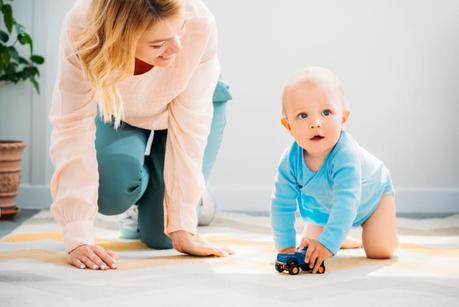
Learning how to crawl appropriately is a complex process, and your child will probably go through various stages until they’re able to support their body adequately.
As a parent, there are a few things that you can do to help them with their development.
- Help your baby strengthen their muscles by laying them on their tummy. This will help your child strengthen the core muscles, as well as the muscles in the head, neck, and arms that later work together to help move the body forward.
- Make sure that your child has a safe area while they’re trying to explore. In the beginning, remove obstacles that can stop or intimidate your child, so they can start crawling comfortably. Later on, when your baby is more confident, you’ll see that he or she is able to go under tables, rotate around objects, and go over cushions to reach their destination.
- It’s a good idea to child-proof your house before your child starts crawling. This will help you guarantee the safety of your baby at all times.
- Use your baby’s favorite toys for encouragement. You can place a toy within a short distance and encourage your infant to reach for it. With time, your child will develop the most efficient technique to successfully reach their toy.
- When your child is crawling on all fours, use your palms to stabilize them. Place your arms behind the baby’s feet to give them something that they can push off to move their body to the front.
- Make sure that you’re encouraging your child all the time. Using positive facial gestures as well as an encouraging tone is something that your child will understand. When they feel self-confident, they will be able to push themselves a little bit further to crawl and walk the way they should.
What Should You Avoid When Your Baby is Crawling?
There are a few things that can affect your baby’s ability to crawl and later walk properly. Avoiding them will help improve your child’s development.
#1 Avoid using baby walkers for a long time.
Spending too much on the walker can be hazardous and will discourage your baby from spending time on the floor while they’re crawling.
When your child doesn’t crawl and depend on the walker, their muscles won’t develop properly, and they might face problems when they later decide to stand up or walk.
#2 Avoid keeping your baby in a seat or a carrier all the time.
Keeping a baby in a seat might be convenient because you can limit their movement when you’re busy or unable to watch them properly.
However, your baby will only learn to crawl, stand, and later walk when they’re given enough time playing and exploring on their own.
#3 Don’t push your child to crawl.
Showing disappointment or frustration with your child’s ability will affect their self-esteem.
Your child will crawl when they’re ready to. Pushing them to learn a skill that they haven’t yet developed will usually slow down the learning process.
My Baby isn’t Crawling- When Should I Worry?
Each child is unique, and a baby who doesn’t crawl might not suffer from any developmental issue.
Some infants who are bigger or heavier than usual might crawl later than others.
Premature babies may also crawl later than others. It’s also common for some children to skip crawling altogether and start walking on their own.
Your child might not be crawling because they’re busy working on other skills that seem more interesting to them.
Some children will talk sooner than others and will start crawling at a later age.
Others will work with their hands and improve their fine motor skills while ignoring crawling for the time being.
You shouldn’t panic if your baby hasn’t started crawling after being 10 months old.
However, you should contact your doctor or health care provider in the following cases.
- You notice that your baby doesn’t maintain eye contact or respond when their name is called.
- Your baby is crawling with one leg out, as this can show that there’s something wrong with the spine or hips.
- Your child is unable to move from one spot to another, even though they’re in a crawling position. This might indicate that there’s a problem with their muscles or coordination.
When Do Babies Start Walking?
Before your baby starts to walk, they might start cruising. This is when they stand and hold an object for balance while pushing themselves to move from one spot to another.
Babies hold edges of furniture or even lean against the wall for support. It’s important to make sure that there are no sharp or shaky objects around that your child might hold onto while they’re trying to cruise.
There’s no specific time frame to tell you when your baby will start walking after crawling.
This can take weeks or months, depending on your baby’s preferences and overall condition.
The average time difference between crawling and walking is about 4 months. This means that your child might start walking between 9 and 15 months.
However, it’s quite common for your child to start walking later, and this shouldn’t alarm you, as long there’s no sign of poor muscle coordination or weakness.
You should see the doctor if you can see that your child is experiencing a lack of control over the body and is unable to maintain a stable position to start crawling or walking.
What Signs Show that my Baby will Walk Soon?
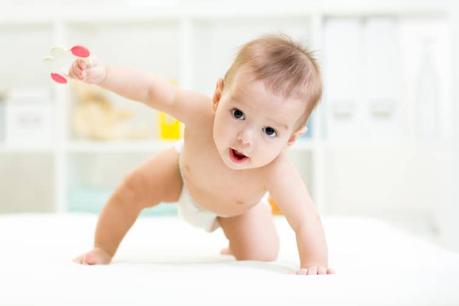
Walking is a crucial milestone in your infant’s life and is met by great anticipation from the baby and the parents.
Before your baby actually starts walking, he or she will show several signs that can alert you that they’re trying to do that.
- Your baby will start pulling themselves to stand while balancing themselves by holding onto the edges of furniture pieces. Your child will try to support their body by placing their hands on the couch or the table leg to give themselves more leverage to stand and move their legs.
- A child will show self-confidence by standing up and pushing themselves to the front. They might fall off, but this level of confidence indicates that they will soon take their first steps without help.
- Cruising or walking while holding onto objects for support is a sign that soon enough, your baby will be confident enough to walk on their own.
- Your child might start to take a few steps at a time before losing balance. You shouldn’t worry because, with practice, your baby will be able to maintain their posture and balance.
- Keep an eye on your baby’s overall behavior. A change in their sleep routine or mode can be attributed to their body and brain working hard to help them walk.
- After you extend your hands to support your baby while they’re standing up, they will attempt to walk with your assistance.
How Can I Encourage my Baby to Walk?
Your child might be under stress while trying to walk on their own for the first time. There are a few things that you can do to help them achieve their goal.
- Watch your baby and use words of encouragement. Offer help when your baby needs it and praise them for every step they take.
- Comfort your child when they fall. In some cases, they might get up and try again, and in others, they might be uncomfortable or in pain.
- Use toys and cooperate with someone else to make walking more fun. The baby can walk between two parents or with siblings, so they can feel less pressure.
- Ask your baby to follow you or extend your hands while moving backward to help them reach you.
When Will My Baby Walk Independently?
From the previous information, you can conclude that there’s no specific time for your baby to start walking without any help.
Some children can walk independently by the time they’re 12 months. Others can wait until they’re 18 months or even older.
Whether your baby starts to walk earlier or later, it doesn’t affect the way they later develop physically and mentally, as long as they’re not showing any signs of overall weakness, physical abnormalities, or lack of response.
Some babies can start standing with or without support by the time they’re 9 or 10 months old.
Others can start as early as 7 or 8 months. If the baby remains restrained in a car, carrier, seat, or sling, he or she will probably start walking later.
If your baby doesn’t try to walk by the time they’re 18 months old, see a doctor. Some children can walk later, and they will be perfectly normal.
Nevertheless, it’s essential to rule out any potential problems, so you can rest assured that your baby is healthy.
What Should I Do if My Baby is a Late Walker?
First, you have to define the word “late.”
There are several factors that can delay the walking milestone for your little one. This, however, doesn’t mean that there’s something wrong with them.
Some children start walking late because they started sitting and crawling late. There’s no problem as they might be focusing on developing other intellectual skills like talking.
If your child is crawling and hasn’t started walking by the time they’re 18 months old, you should see a doctor or medical care provider.
The doctor will run a few tests to make sure that there’s nothing wrong with your child.
Conclusion
As a parent, you need to understand that every child is unique. Your child might experience different transitions and milestones, and this shouldn’t alarm you, as long as a doctor has confirmed that your child is safe.
There are several types of crawling that your child might experience. Crawling with one leg out isn’t necessarily dangerous or abnormal, but can weaken the muscles on one side of the body and cause problems later one.
However, your child might grow out of it naturally. It’s recommended that you always check with a doctor to make sure that there’s nothing wrong with your baby.
